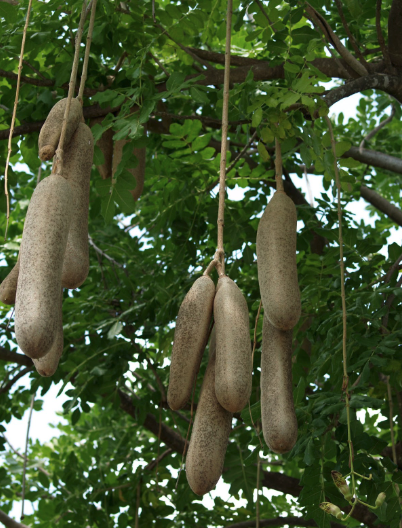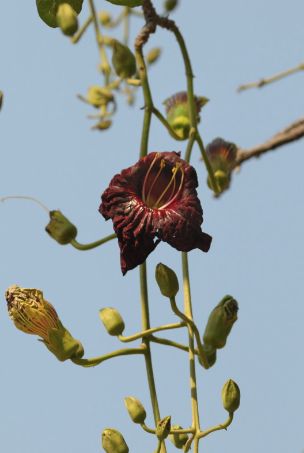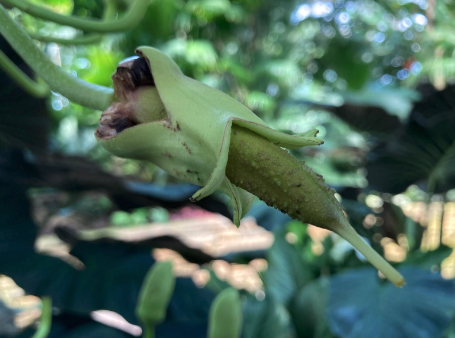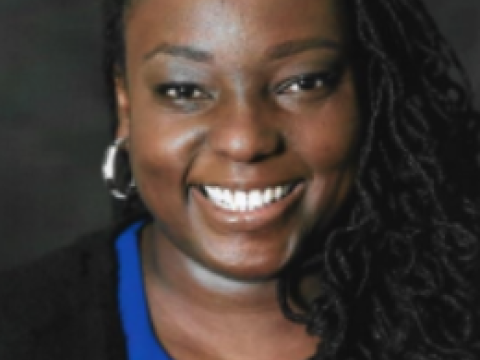
Sausage Tree
You may have noticed large corn dog or sausage-like structures hanging from two trees in the Matthaei Botanical Gardens’ conservatory, but you would not want to put these sausages between buns at a ball game. These brats are actually the fruit of the aptly named sausage tree. Humans can’t eat this fruit, which is considered poisonous, but its large size and unique appearance makes it a popular attraction in the conservatory. Apart from resembling sausage, the tree’s fruit also stands out as odd by weighing up to 22 pounds and hanging from stalks that can grow over 6 feet long.
Getting a sausage tree to produce its signature fruit is no easy feat. Like all flowering plants, the sausage tree produces fruit from its flowers after pollen meets ovule, but unlike many flowering plants, a sausage tree’s flowers are self-incompatible. To yield the plant’s impression of sausage, pollen from one genetically distinct tree must be transferred to another’s stigma – part of the flowers’ female reproductive structure.
In Sub-Saharan Africa, where the tree naturally grows, bats, birds, and bushbabies transfer pollen between sausage trees, but in the absence of African bats and bushbabies, people must pollinate sausage trees. Matthaei horticulturists collect pollen from one of the conservatory’s two sausage trees on a paint brush then transfer it to the stigma of the other. Transferring pollen can be a sticky business, according to Michael Palmer, Matthaei Botanical Gardens’ Research and Collections Coordinator. “You don’t want to stand under the flowers because they actually have quite a bit of nectar in them, and if you knock them too much, they can dump nectar on your hair,” said Palmer.

Unfortunately, the two trees in the conservatory do not always bloom in synchrony. One tree sometimes blooms early and loses its flowers before the other’s flowers mature. Other times, only one tree produces well-developed flowers. Under such circumstances, gardens need to obtain sausage tree pollen from elsewhere to produce sausage fruit. For this reason, horticulturists from Matthaei Botanical Gardens exchanged sausage tree pollen with the Anna Scripps Whitcomb Conservatory on Belle Isle in the summer of 2022. Matthaei benefitted from last year’s exchange because only one of their trees bloomed the prior year, and the Anna Scripps Whitcomb Conservatory benefited because they only have one sausage tree.
This exchange was the first for both organizations because Anna Scripps Whitcomb Conservatory’s tree is relatively young. According to Jeremy Kemp, the Head Horticulturist at the Anna Scripps Whitcomb Conservatory, they “put in [their] sausage tree probably seven years ago. It was a tiny little wimp of a tree, and it generally takes five to seven years before a sausage tree will start bearing flowers.”
Kemp also served as pollen postman during the exchange. Once his tree began to bloom, Kemp plucked a flower from its panicle, the chandelier-like structure that bore it, choosing a flower that was still closed to help contain the pollen. He then immediately delivered the flower to Matthaei Botanical Gardens, where he then opened it up and pollinated the sausages tree with the usual paintbrush method. Before Kemp left, he took a flower from Matthaei’s sausage tree to repeat the process back at his home conservatory.
Following the exchange, both conservatories had sausage fruits in short order. The pollinated flowers kick off the process by shedding their petals, and “within three days you can see little fruit developing,” said Kemp, who is still amazed by the speed at which the fruit develop. The fruit are fully formed seven weeks after pollination but will hang from the tree for over a year before finally falling off their branches, so there is plenty of time for the conservatory’s visitors to observe the fruit once they have formed. At the time of writing this article, sausage fruit from last year’s pollen exchange still hung from the trees at the Anna Scripps Whitcomb Conservatory and Matthaei Botanical Gardens. At the time this article was written, sausage fruit still hung from Matthaei’s tree around 6 months after the flower was pollinated.

Kemp is excited to finally display fruit on Belle Isle’s sausage tree, which he views as “a gateway plant” for the conservatory’s visitors to get excited about plant biodiversity. “The fruit is pretty otherworldly for most people unless you live in Africa,” said Kemp, who likened it to the bizarre wonders inside Willy Wonka’s chocolate factory, “it is exciting to see oranges and other things that we have in the conservatory, but to see something like sausage tree fruit really can capture peoples’ imaginations,” said Kemp.
Matthaei Botanical Gardens and the Anna Scripps Whitcomb Conservatory will continue to exchange sausage tree pollen in future years to ensure both conservatories can reliably showcase the tree’s iconic fruit.
Derek Smith tells stories about science and the natural world for a wide audience. He has written for institutions, blogs, and in magazines as a freelancer, intern, and volunteer. His writing has been featured in the ScienceBites blogs and the Matthaei Botanical Gardens and Nichols Arboretum newsletter.



